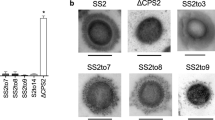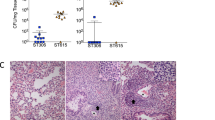Abstract
The human pathogenic microorganismStreptococcus pyogenes can resist against phagocytic attack of human granulocytes. Streptococcal M protein and hyaluronic acid were identified as virulence factors involved in this protection. So far, no experiments have been reported which describe the contribution of both components together in one system. We used the chicken embryo as an in vivo phagocytosis model to investigate the role of both components on the virulence of streptococci. For this, isogeneic mutants of group A streptococcal strains (GAS) which lack hyaluronic acid capsule (cap−) or M protein (M−) expression were used for infection and their virulence was compared with laboratory strains which had lost their ability to produce one or both virulence factors after long-time laboratory passages on blood agar. The experiments revealed that strains producing both M protein and hyaluronic capsule were higly, virulent. Only 1–10 colonyforming units were enough to cause a 50% lethality of 12-day-old chicken embryos. Those strains lacking one of these components showed a significant decrease in virulence. Finally, strains which failed to express either hyaluronic acid or M protein showed an additional tenfold decrease in virulence. This indicates a partial contribution of both M protein and hyaluronic acid to the virulence of GAS in the chicken embryo.
Similar content being viewed by others
Abbreviations
- cap + orcap − :
-
hyaluronic acid capsule positive or negative strains
- FBG :
-
fibrinogen
- FN :
-
fibronectin
- GAS :
-
group A streptococci
- HA :
-
hyaluronic acid
- HSA :
-
human serum albumin
- M + orM − :
-
M protein expressing or not expressing strains
References
Donaldson PMW, Naylor B, Lowe JW, Gouldesbrough DR (1993) Rapidly fatal necrotizing fasciitis caused by streptococcus pyogenes. J Clin Pathol 46:617–620
Hoge CW, Schwartz B, Talkington DF, Breiman RF (1993) The changing epidemiology of invasive group-A streptococcal infections and the emergence of streptococcal toxic shock-like syndrome—a retrospective population-based study. JAMA 269:384–389
Köhler W (1990) Streptococcal toxic shock syndrome. Zentralbl Bakteriol 272:257–264
Albani S (1994) Infection and molecular mimicry in autoimmune disease of childhood. Clin Exp Rheumatol 12 [Suppl 10]: 35–41
Buzio C, Allegri L, Mutti A, Perazzoli F, Bergamaschi E (1994) Significance of albuminuria in the follow-up of acute poststreptococcal glomerulonephritis. Clin Nephrol 41:259–264
Stollermann GH (1993) Variation in group A streptococci and the prevalence of rheumatic fever—a half-century vigil. Ann Intern Med 118:467–469
Lancefield RC (1962) Current knowledge of the type-specific M antigens of group A streptococci. J Immunol 89:307–313
Courtney HS, Bronze M, Dale JB, Hasty DL (1994) Analysis of the role of M24 protein in group A streptococcal adhesion and colonization by use of ω-interposon mutagenesis. Infect Immun 62:4868–4873
Tylewska SK, Fischetti VA, Gibbons RJ (1988) Binding selectivity ofStreptococcus pyogenes and M protein to epithelial cells differs from that of lipoteichoic acid. Curr Microbiol 16:209–266
Åkesson P, Schmidt KH, Cooney J, Björck L (1994) M1 and protein H: IgGFc- and albumin-binding streptococcal surface proteins encoded by adjacent genes. Biochem J 300:877–886
Kehoe M (1994) Cell-wall-associated proteins in Gram-positive bacteria. In: Ghuysen JM, Hakenbeck R (eds) Bacterial cell wall. (New comprehensive biochemistry, vol 27), Elsevier, Amsterdam, pp 217–261
Raeder R, Otten RA, Chamberlin L, Boyle MDP (1992) Functional and serological analysis of type-II immunoglobulin, g-binding proteins expressed by pathogenic group-A streptococci. J Clin Microbiol 30:3074–3081
Retnoningrum DS, Cleary PP (1994) M12 protein fromStreptococcus pyogenes is a receptor for immunoglobulin G3 and human albumin. Infect Immun 62:2387–2394
Schmidt KH, Wadström T (1990) A secreted receptor related to M1 protein ofStreptococcus pyogenes binds to fibrinogen, IgG, and albumin. Zentralbl Bakteriol 273:216–228
Schmidt KH, Mann K, Cooney J, Köhler W (1993) Multiple binding of type 3 streptococcal M protein to human fibrinogen, albumin and fibronectin. FEMS Microbiol Immunol 7:135–144
Stenberg L, Otoole P, Lindahl G (1992) Many group-A streptococcal strains express 2 different immunoglobulin-binding proteins, encoded by closely linked genes-characterization of the proteins expressed by 4 strains of different M-type. Mol Microbiol 6:1185–1194
Podbielski A (1993) 3 Different types of organization of the vir regulon in group-A streptococci. Mol Gen Genet 237:287–300
Whitnack E, Dale JB, Beachey EH (1984) Common protective antigens of group A streptococcal M proteins masked by fibrinogen. J Exp Med 159:1201–1212
Wagner B, Schmidt KH, Wagner M, Köhler W (1986) Albumin bound to the surface of M-protein positive streptococci increased their phagocytosis by human polymorphonuclear leucocytes in the absence of complement and bactericidal antibodies. Zentralbl Bakteriol 261:432–446
Wessels MR, Moses AE, Goldberg JB, DiCesare TJ (1991) Hyaluronic acid capsule is a virulence factor for mucoid group A streptococci. Proc Natl Acad Sci USA 88:8317–8321
Wessels MR, Goldberg JB, Moses AE, DiCesare TJ (1994) Effects of virulence of mutations in a locus essential for hyaluronic acid capsule expression in group A streptococci. Infect Immun 62:433–441
Wessels M, Bronze MS (1994) Critical role of the group A streptococcal capsule in pharyngeal colonization and infection in mice. Proc Natl Acad Sci USA 91:12238–12242
Whitnack E, Bisno AL, Beachey EH (1981) Hyaluronate capsule prevents attachment of group A streptococci to mouse peritoneal macrophages. Infect Immun 31:985–991
Schmidt KH, Gerlach D, Wiesner J, Reichardt W, Ozegowski JH, Köhler W (1993) Susceptibility of chicken embryos to group A streptococci: correlation with fibrinogen binding. FEMS Immunol Med Microbiol 7:231–240
Tijssen P (1985) Practice and theory of enzyme immunoassays. In: Burdon RH, Van Knippenberg RH (eds) Laboratory techniques in biochemistry and molecularbiology. Elsevier, Amsterdam New York Oxford
DiFerrante N (1956) Turbidimetric measurement of acid mucopolysaccharides and hyaluronidase activity. J Biol Chem 220:303–306
Schmidt KH, Åkesson P, Köhler W, Björck L (1992) Isolation fromStreptococcus pyogenes of extracellular M1 protein which binds to fibrinogen, albumin and IgG. In: Orefici G (ed) New perspectives on streptococci and streptococcal infections. Zentralbl Bakteriol 22 [Suppl]:206–207
Tiefenberg J, Vogel L, Kretschmer RR, Padnos D, Gotoff SP (1978) Chicken embryo model for type III group B beta-hemolytic streptococcal septicemia. Infect Immun 19:481–485
Hirsch JG, Church AB (1960) Studies of phagocytosis of group A streptococci by polymorphonuclear leucocytes in vitro. J Exp Med 111:309–322
Manjula BN (1988) Molecular aspects of the phagocytosis resistance of the group A streptococci. Eur J Epidemiol 4:289–300
Mizejewski GJ (1973) The concept of an embryonic reticuloen-dothelial system (ERES) in the developing chick. J Reticuloendothel Soc 14:171–180
Seto F (1981) Early development of the avian immune system. Poult Sci 60:1981–1995
Author information
Authors and Affiliations
Corresponding author
Rights and permissions
About this article
Cite this article
Schmidt, KH., Günther, E. & Courtney, H.S. Expression of both M protein and hyaluronic acid capsule by group A streptococcal strains results in a high virulence for chicken embryos. Med Microbiol Immunol 184, 169–173 (1996). https://doi.org/10.1007/BF02456131
Received:
Issue Date:
DOI: https://doi.org/10.1007/BF02456131




